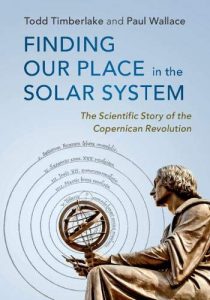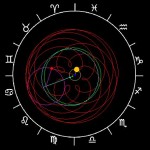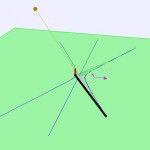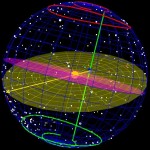Finding Our Place in the Solar System: The Scientific Story of the Copernican Revolution
Overview
This page contains curricular materials that I have developed to accompany my book (co-authored with Paul Wallace) Finding Our Place in the Solar System. I use these materials, along with the book, to teach a course on the history of astronomy for non-science majors. The course explores the historical development of astronomy from the Ancient Greeks to Isaac Newton. The main purpose of the course is to use ancient and early modern astronomy as examples to illustrate how scientific theories are developed and tested and how scientific knowledge changes over time.
I teach the course using interactive methods. Students work in small groups to complete worksheet-based activities. Most of the activities involve using computer simulations. Some of the activities make use of free planetarium software (Stellarium). Most activities use computer simulations that I have created using the Easy Java Simulations (EJS) package. These simulations are part of the Open-Source Physics (OSP) project and are available for free using the links below, along with all of the worksheets for the activities. Any of these materials can be used for free, with or without the book (although obviously I think they work better with the book).
For a more detailed description of the course see http://berryactivelearning.blogspot.com/2009/06/ast-120-copernican-revolution.html.
You can also download my most recent course syllabus.
Finding Our Place in the Solar System
 Finding our Place in the Solar System gives a detailed account of how the Earth was displaced from its traditional position at the center of the universe to be recognized as one of several planets orbiting the Sun under the influence of a universal gravitational force. The transition from the ancient geocentric worldview to a modern understanding of planetary motion, often called the Copernican Revolution, is one of the great intellectual achievements of humankind. This book provides a deep yet accessible explanation of the scientific disputes over our place in the solar system and the work of the great scientists who helped settle them. Readers will come away knowing not just that the Earth orbits the Sun, but why we believe that it does so. The Copernican Revolution also provides an excellent case study of what science is and how it works. Published by Cambridge University Press in 2019. You can click the image to purchase this book from Amazon..
Finding our Place in the Solar System gives a detailed account of how the Earth was displaced from its traditional position at the center of the universe to be recognized as one of several planets orbiting the Sun under the influence of a universal gravitational force. The transition from the ancient geocentric worldview to a modern understanding of planetary motion, often called the Copernican Revolution, is one of the great intellectual achievements of humankind. This book provides a deep yet accessible explanation of the scientific disputes over our place in the solar system and the work of the great scientists who helped settle them. Readers will come away knowing not just that the Earth orbits the Sun, but why we believe that it does so. The Copernican Revolution also provides an excellent case study of what science is and how it works. Published by Cambridge University Press in 2019. You can click the image to purchase this book from Amazon..
Projects
The course is primarily built around several individual student projects. The projects give students the opportunity to apply what they have learned in the course. Projects focus on tracking the sun, observing planetary motions, constructing Ptolemaic and Copernican solar system models based on observational data, using Kepler’s laws to predict the motion of a comet, and examining arguments for and against the Copernican theory.
All but the last of the projects are based on simulated observations that students make from a planet in a fictitious solar system. Students must take what they have learned about our solar system and apply it to understanding their new home planet and its environs. Each student (up to 30 students) receives two individualized computer simulations that they use to make the required observations (one for the motion of the Sun, another for the motion of the planets). The observational data they collect is then used to construct models of the solar system and answer various other questions. The individualized simulations are available below.
Individualized Simulations
- Gnomon Shadow Simulations
- Download a single example of a gnomon simulation: ejs_NewPlanetGnomon1.jar.
- Download a zip archive containing all 30 gnomon simulations: NewPlanetGnomons.
- Note: you should assign the 30 gnomon simulations at random to the students in your class and privately document which gnomon simulation (by number) each student receives. Change the name of the gnomon file from “ejs_NewPlanetGnomon1.jar” to “StudentNameGnomon.jar” (using the actual names of your students, of course) and then distribute the files to your students. That way your students will not know which system they have, so even if they get a copy of the solar system data files (see below) they will not be able to determine the data for their solar system without doing the necessary work (unless they want to rely on a 1 in 30 chance of guessing correctly).
- Solar System Simulations
- Download a single example of a solar system simulation: ejs_YourSolarSystem01.jar.
- Download a zip archive containing all 30 solar system simulations: SolarSystems.
- Note: each student should receive the solar system that goes with the gnomon program they received. For example, if a student received NewPlanetGnomon3.jar, then they should also get YourSolarSystem03.jar. If you did not assign the gnomon project, then the solar systems can be assigned randomly. Change the name of the solar system file from “ejs_YourSolarSystem01.jar” to “StudentNameSolarSystem.jar” (using the actual names of your students, of course) and then distribute the files to your students. That way your students will not know which system they have, so even if they get a copy of the solar system data files (see below) they will not be able to determine the data for their solar system without doing the necessary work (unless they want to rely on a 1 in 30 chance of guessing correctly).
Project Handouts, Etc.
The list below provides links to zip archives that contain the handouts (in PDF and LaTeX), grading rubrics (if available), and data files (in MS Excel format) for each project, as well as a listing of the relevant activities and labs.
- Tracking the Sun. In this project students must determine the length of the solar day, the time of local noon, the length of the tropical year, the dates of solstices and equinoxes, the obliquity of the ecliptic, latitude and longitude of various locations, the range of latitudes for the tropical, arctic, and antarctic zones, and the radius of the planet. This is all accomplished through observations of a simulated shadow cast by a gnomon at three different locations on their home planet.
- Files: TrackingSun.
- Activities/Labs: Shadows and Gnomons, Eratosthenes Measures the Earth, The Celestial Sphere and the Motion of the Sun, and The Celestial Globe.
- Observing Your Solar System. In this project students must determine the number of planets in their individualized solar system (see below), classify each as inferior or superior, and measure various important astronomical quantities.
- Files: ObservingPlanets.
- Activities/Labs: The Dome of the Sky, Motion of the Sun, The Planets.
- Ptolemaic Modeling. In this project students must construct a Ptolemaic model for their solar system using the observational data gathered in the first project.
- Files: PtolemyModel.
- Activities/Labs: Two Sphere Universe, Spheres of Eudoxus, Ptolemy’s Syntaxis, Ptolemy’s Universe.
- Copernican Modeling. In this project students must construct a Copernican model for their solar system using the observational data gathered in the first project.
- Files: CopernicusModel.
- Activities/Labs: Motions of the Earth, Copernicus’ Theory of the Planets, The Scale of the Universe.
- Kepler’s Laws and Lazlo’s Comet. In this project students are given a diagram showing the orbit of a comet in their solar system. They must use this diagram, along with Kepler’s Three Laws of planetary motion, to determine properties of the comet’s orbit and predict its location on the sky at a future time. There are five different versions of the diagram available in GGB (editable GeoGebra format) or PNG (bitmap image format).
- Files: KeplerComet.
- Activities/Labs: Parallax, Earth’s Orbit: Kepler’s Second Law, Mars’ Orbit: Kepler’s First Law, Harmonices Mundi, Kepler’s Laws.
- Defending the Copernican Theory. In this project students must use concepts from Newtonian physics to respond to a letter, from a fictional 17th century student of natural philosophy, attacking the Copernican theory.
- Files: DefendNewton.
- Activities/Labs: almost any activity or lab from Tycho to Newton could help with this project.
- Old Project: Observing the Moon. In this project students make observations of the real Moon and try to make sense of their observations using a simple model of lunar phases. I did not assign this project the last time I taught the course, but only because there was not enough time with all of the other projects. It is a perfectly good project that gets students making their own (real!) observations.
- Files: ObserveMoon.
- Activities/Labs: The Moon, Observing the Moon.
Computer Simulations
The computer simulations come packaged in the form of a single Java executable file (JAR file). The programs should run on any computer with Java 1.5 (or newer) installed. All of the simulations were created using Easy Java Simulations (EJS) and are open-source, so you are free to alter and redistribute them (but please see the Terms of Use before doing so). You are free to use the simulations any way you wish, but I have developed a series of worksheet-based activities that use the simulations (as well as some commercial software and some physical equipment) guide students through an exploration of this material. The worksheets are available below.
Download ejs_CopernicanRevolution.jar
Activities and Labs
The table below contains a list of topics (arranged into 7 groups) that students explore in my Copernican Revolution course. For each topic I provide a list of the simulations related to that topic (all simulations, except Stellarium and the Revolution of the Moons of Jupiter, are contained within the CopernicanRevolution.jar package linked above), and a list of any other materials needed to complete the activity. The worksheets designated with “(A)” are activities designed to be used in a single 75 minute class period (with some time left over for a short lecture review). The worksheets designated with “(L)” are laboratory exercises designed to be used in a single 120 minute laboratory period. Ideally these materials should be used in the order in which they are listed, but there is some flexibility (especially with some of the labs).
The worksheets are available in PDF format using the link below. You are free to use (and even change) the worksheets, but please see the Terms of Use before doing so. If you wish to edit the worksheets, and you know how to use LaTeX (or are willing to learn), you can download a package containing all the .tex files and other necessary files (images, etc.) for all of the worksheet.
- PDF Handouts for all activities and labs: PDFworksheets.
- LaTeX source for all activities and labs: LaTeXsource.
If you would like to edit the worksheets but need them in a different format please email me (ttimberlake@berry.edu) and I may be able to accommodate you.
Please watch out for typos and other errors in these handouts. I cannot guarantee that they are without flaws – but the handouts posted here are all materials that I have used in my own class. Please work carefully through the exercises yourself before you give them to your students!
| Group | Topic | Simulations | Other Materials |
|---|---|---|---|
| Science | The Game of Science (A) | none | Game of Science Materials |
| Observations | The Dome of the Sky (A) | Stellarium | none |
| Motion of the Sun (A) | Stellarium | none | |
| The Celestial Globe (L) | LocalCoordinates, EquatorialCoordinates, CelestialGlobe | a celestial globe | |
| The Zodiac and Precession (A) | Stellarium, CelestialGlobe | none | |
| Shadows and Gnomons (L) | Gnomon | none | |
| Two Sphere Universe (A) | Stellarium | none | |
| Eratosthenes Measures the Earth (L) | AngularSize, Stellarium, Eratosthenes |
none | |
| The Moon (A) | Stellarium | none | |
| Phases and Eclipses (L) | MoonPhases, SolarLunarEclipse | nighttime observations | |
| The Planets (A) | Stellarium | none | |
| Ancient Greeks | Aristotle’s Physics (A) | none | steel ball, graduated cylinder, pennies, book |
| Spheres of Eudoxus (A) | SpheresOfEudoxus, SuperiorPtolemaic, InferiorPtolemaic | none | |
| Ptolemy’s Syntaxis (A) | Eccentric, EpicycleEccentric, Equant, SuperiorPtolemaic, InferiorPtolemaic | none | |
| Ptolemy’s Universe (L) | SuperiorPtolemaic, InferiorPtolemaic | none | |
| Copernicus | Motions of the Earth (A) | DailyRotation, EarthOrbit | none |
| Copernicus’ Theory of the Planets (A) | CopernicanSystem | none | |
| The Scale of the Universe (A) | CopernicanSystem, EarthOrbit | none | |
| Tycho | The Tychonic System (A) | CopernicanSystem, PtolemyCopernicusTycho | none |
| Parallax (L) | Parallax2D, Stellarium | none | |
| Size of Stars (L) | none | none | |
| The Comet of 1577 (A) | none | Starry Night or other commercial software that shows comets | |
| Kepler | Kepler’s Mysterium (A) | MysteriumCosmographicum2D, MysteriumCosmographicum3D | shapes for building Platonic solids |
| The Species Motrix (A) | KeplerAstronomiaNovaOrbits, SpeciesMotrix, KeplerInertia | none | |
| Earth’s Orbit: Kepler’s Second Law (A) | SecondLawCircle | compass, straight edge | |
| Mars’ Orbit: Kepler’s First Law (A) | KeplerAstronomiaNovaOrbits | none | |
| Harmonices Mundi (A) | none | none | |
| Kepler’s Laws (L) | KeplerSystem | ruler | |
| Galileo | Sunspots and Solar Rotation (L) | GalileoSunspots | ruler |
| Message of the Stars (A) | GalileoMoonMountain, VenusPhases | none | |
| Falling Bodies (A) | InclinedPlane | lead ball, wood ball | |
| The Moons of Jupiter (L) | Revolution of the Moons of Jupiter CLEA program | none | |
| Neutral Motions (A) | InclinedPlane, ProjectileMotion | none | |
| Freefall: Aristotle vs. Galileo (L) | none | Free Fall apparatus (Pasco, Cenco, etc) | |
| Newton | Newton’s Laws of Motion (A) | CorollaryOne | none |
| Centripetal Forces (A) | CentripetalForce, InverseSquare | none | |
| Universal Gravitation (A) | NewtonsMountain | none |
Credits
- Paul Wallace first developed this course on the Copernican Revolution and wrote the first version of the textbook for the course. He also developed the original versions of the laboratory exercises. Without his hard work and inspiration the Copernican Revolutions course at Berry would not exist.
- All of the simulations were developed using the Easy Java Simluations authoring tool by Francisco Esquembre (see the EJS Wiki page for more information).
- EJS is part of the Open Source Physics project by Wolfgang Christian and collaborators (see the OSP page on ComPADRE for more details).
- Wolfgang Christian and Mario Belloni provided much helpful advice on improving the simulations.
- The simulations were packaged using Launcher and LaunchBuilder by Doug Brown.
- Todd Timberlake developed all of the EJS simulations in the CopernicanRevolution.jar and ejs_astronomy.jar packages. He created all of the handouts for the activities and made significant modifications to the lab handouts originally developed by Paul Wallace.
- A couple figures in the handouts have been borrowed from sources that I now can’t remember. (If they are yours, please let me know so I can either cite you or remove the figures if you wish.)
Terms of Use
All of the materials on this page are available free of charge. Feel free to download the materials and explore them with no obligation whatsoever. However, if you use any of these materials in a class please contact me (ttimberlake@berry.edu) to let me know. I would like to receive feedback on the simulations and the worksheets (especially if you find an error!) and I would like to keep track of where they are being used. If you make any modifications of the simulations or worksheets I would like to know about it (if you made it better then I want to use your improved version!).
The Java programs in the CopernicanRevolution.jar package are Open Source Physics (OSP) programs that were created using Easy Java Simulations (EJS) and are freely distributable under the GNU GPL license. For more information about the Open Source Physics project visit http://www.compadre.org/osp/.

All of the curricular materials (including the narratives in the Launcher package) are copyrighted by Todd Timberlake and/or Paul Wallace and are licensed under a Creative Commons Attribution-Noncommercial-Share Alike 3.0 Unported License. You may modify and redistribute these materials for non-commercial use as long as you clearly cite the original author (Todd Timberlake for all simulations materials and the activity handouts, Paul Wallace and Todd Timberlake for the lab handouts) and release the materials under the same license.
Presentations On This Material
I have several publications and presentations related to this material and the links below provide access to those materials.
- “Home, Sweet New Home – Astronomy for Students Under Alien Skies” paper published in issue 20 (Summer 2014) of The Classroom Astronomer. Preprint: AlienSkiesPreprint.
- “Modeling the History of Astronomy: Ptolemy, Copernicus, and
Tycho”- Paper published in Astronomy Education Review: http://portico.org/stable?au=pgg3ztfcvw0
- Poster presented at the 2013 Winter Meeting of the
American Association of Physics Teachers, New Orleans, LA,
January 2013: PtolemyCopernicusPoster
- “A Body Falling Through the Earth: Newton versus Hooke”
talk given at the 2012 Summer Meeting of the American Association
of Physics Teachers, Philadelphia, PA, July 2012. Slides and computer simulations available here. - “From Ptolemy to Einstein: Using Computer Simulations in
Astronomy” workshop with Mario Belloni and Wolfgang Christian at
the 2012 Summer Meeting of the American Association of Physics
Teachers, Philadelphia, PA, July 2012. Workshop materials available here. - “Using Computer Simulations in Introductory Astronomy,”
(with Mario Belloni)
invited talk at the 2010 Summer Meeting of the American
Association of Physics Teachers, Portland, OR, July 2010.- Slides:TimberlakeAAPTSum2010
- Simulations Package: ejs_astronomy_AAPT2010.jar
- “Exploring the Copernican Revolution through computer simulations,” International History, Philosophy and Science Teaching Group Biennial Conference, University of Notre Dame, June 2009. Slides: TimberlakeIHPST09
- “Exploring the Copernican Revolution through computer simulations,” 2009 Summer Meeting of the American Association of Physics Teachers, University of Michigan, July 2009. Poster: TimberlakeAAPT09_CR
- “Using Computer Simulations to Explore the History of Astronomy,”
workshop presented at the 2009 Meeting of the European Science
Education Research Association, Istanbul, Turkey, September
2009.- Slides: TimberlakeESERA09
- Sample activity handout: ScaleOfUniverseESERA
- Simulations Package: ejs_astronomy.jar
- Paper in ESERA Proceedings: TimberlakeLetterESERA09


